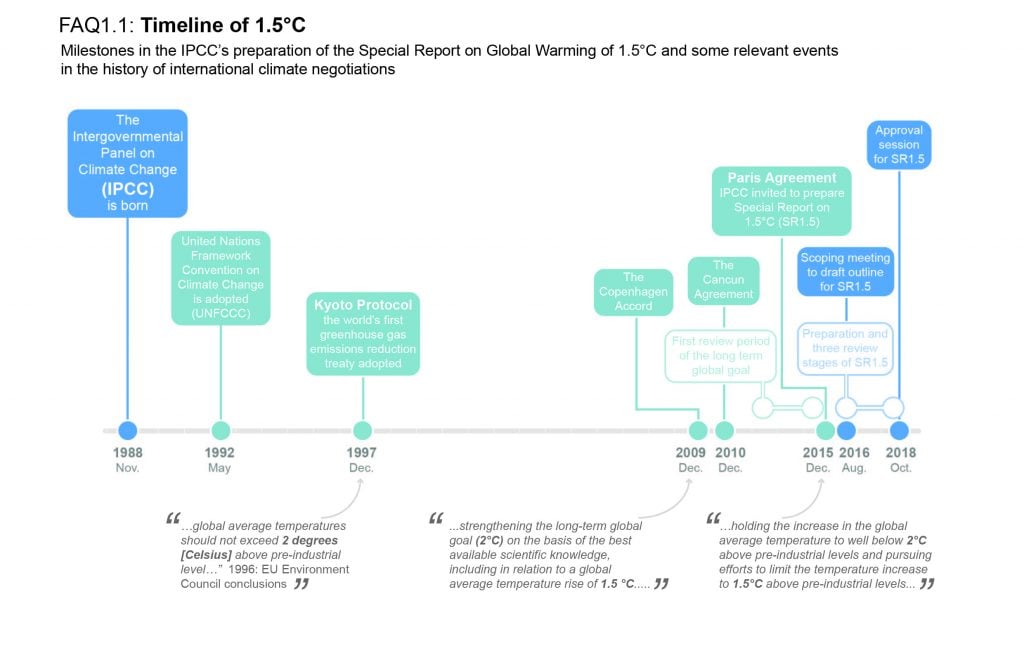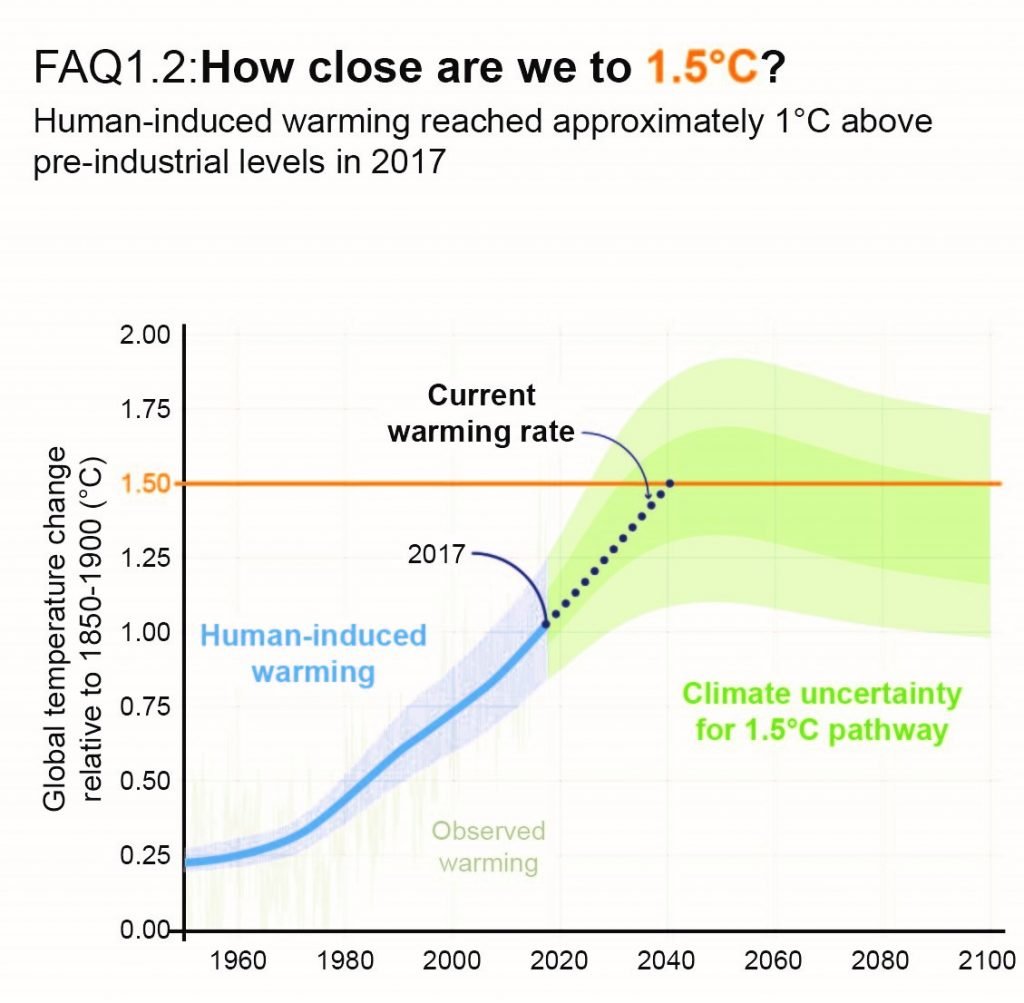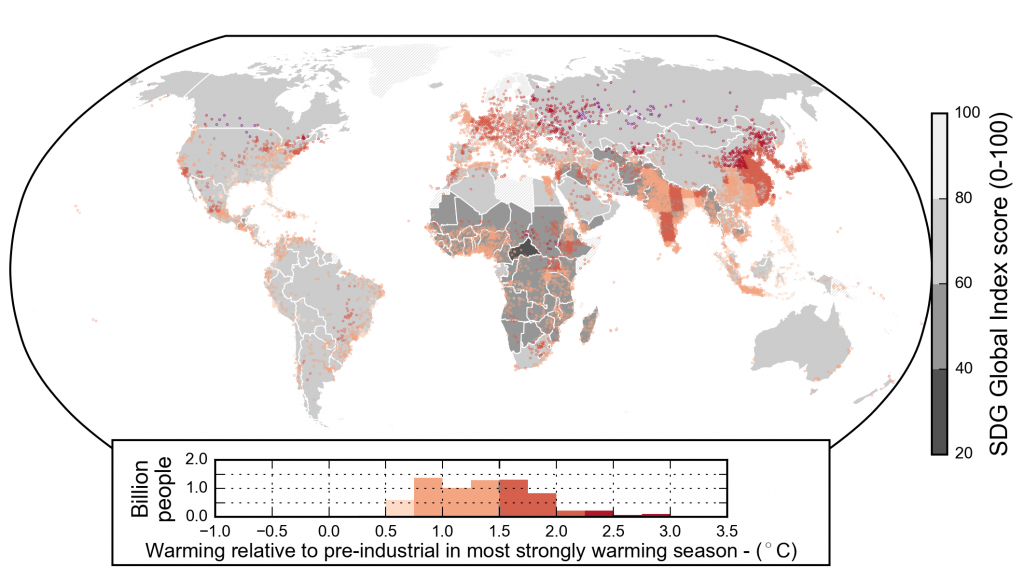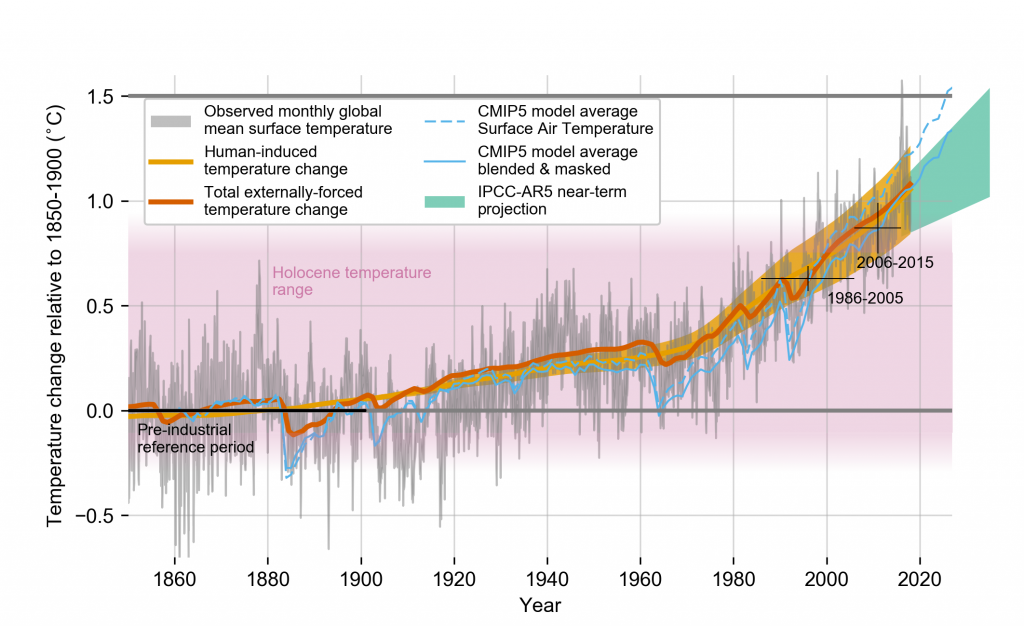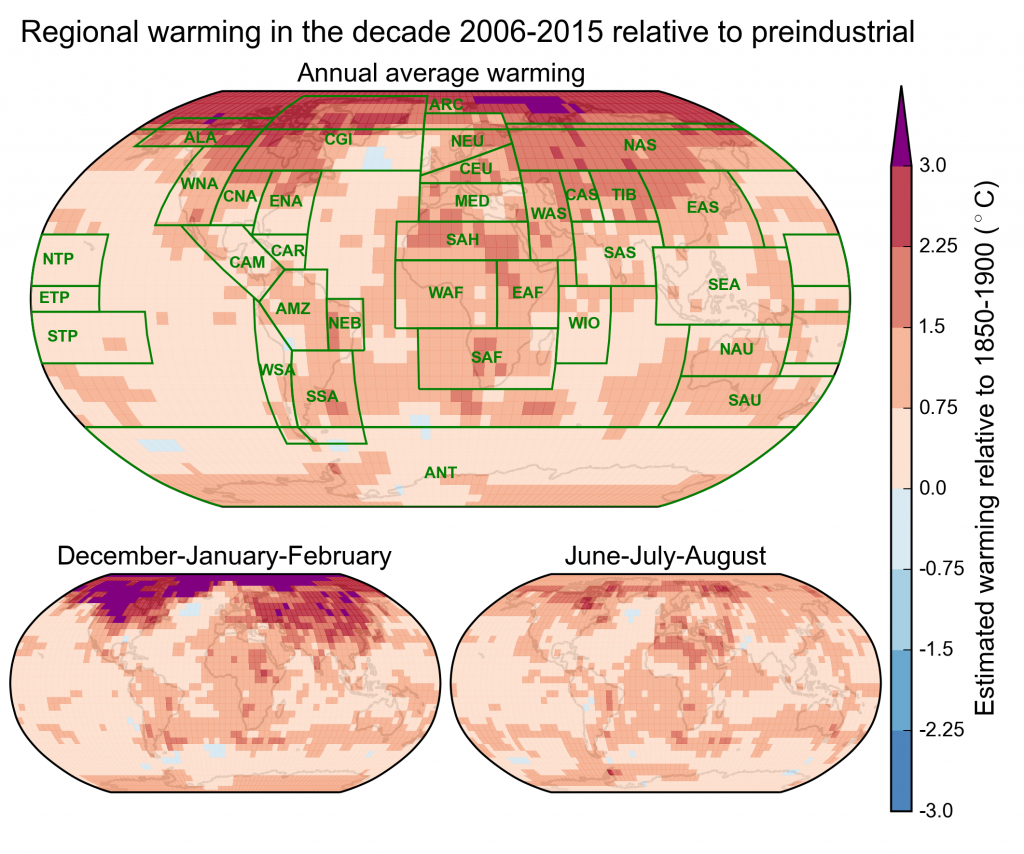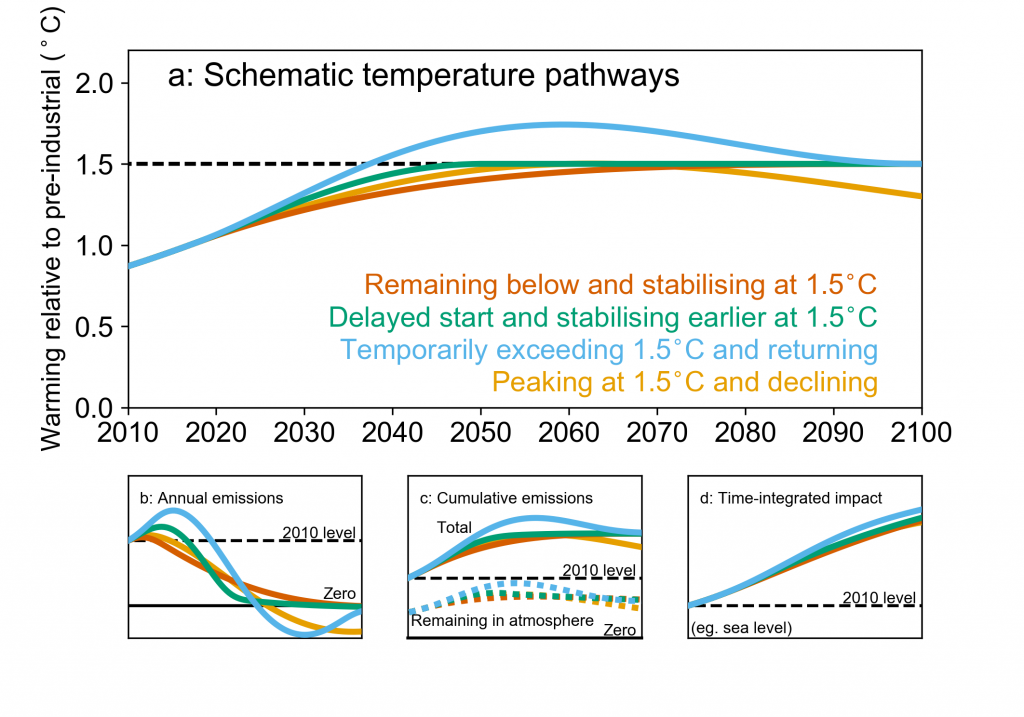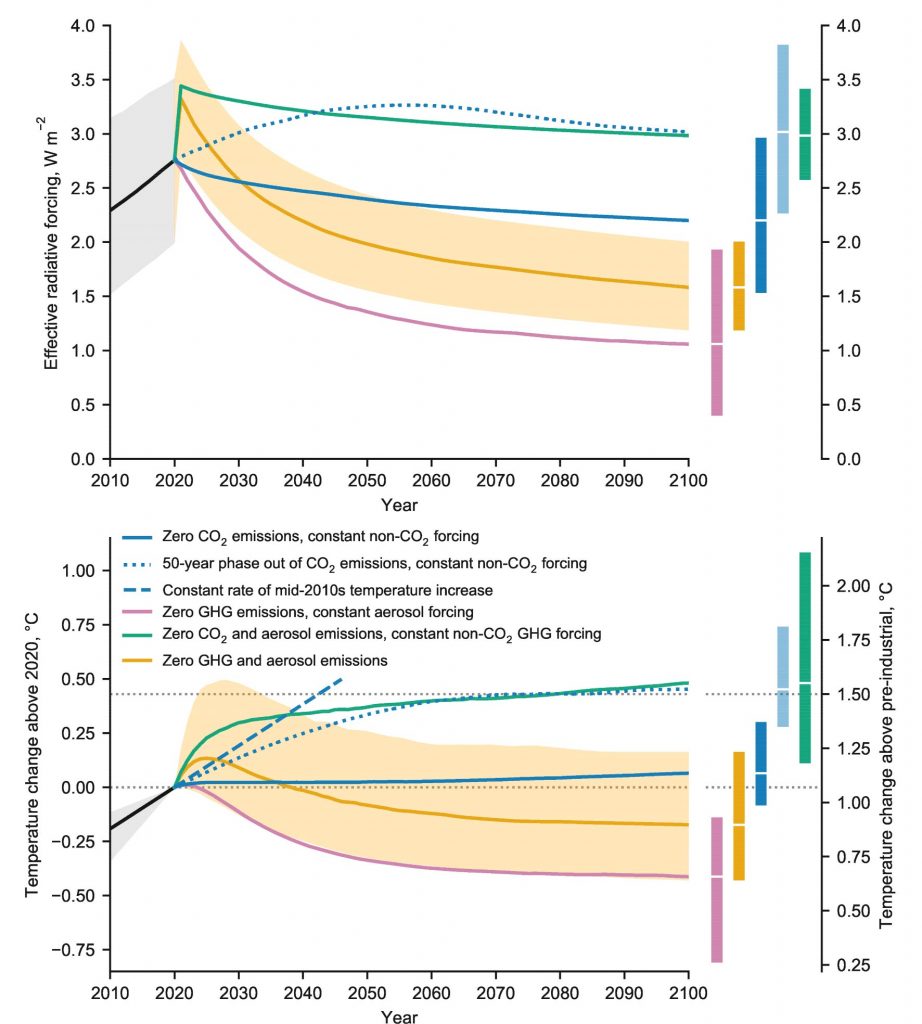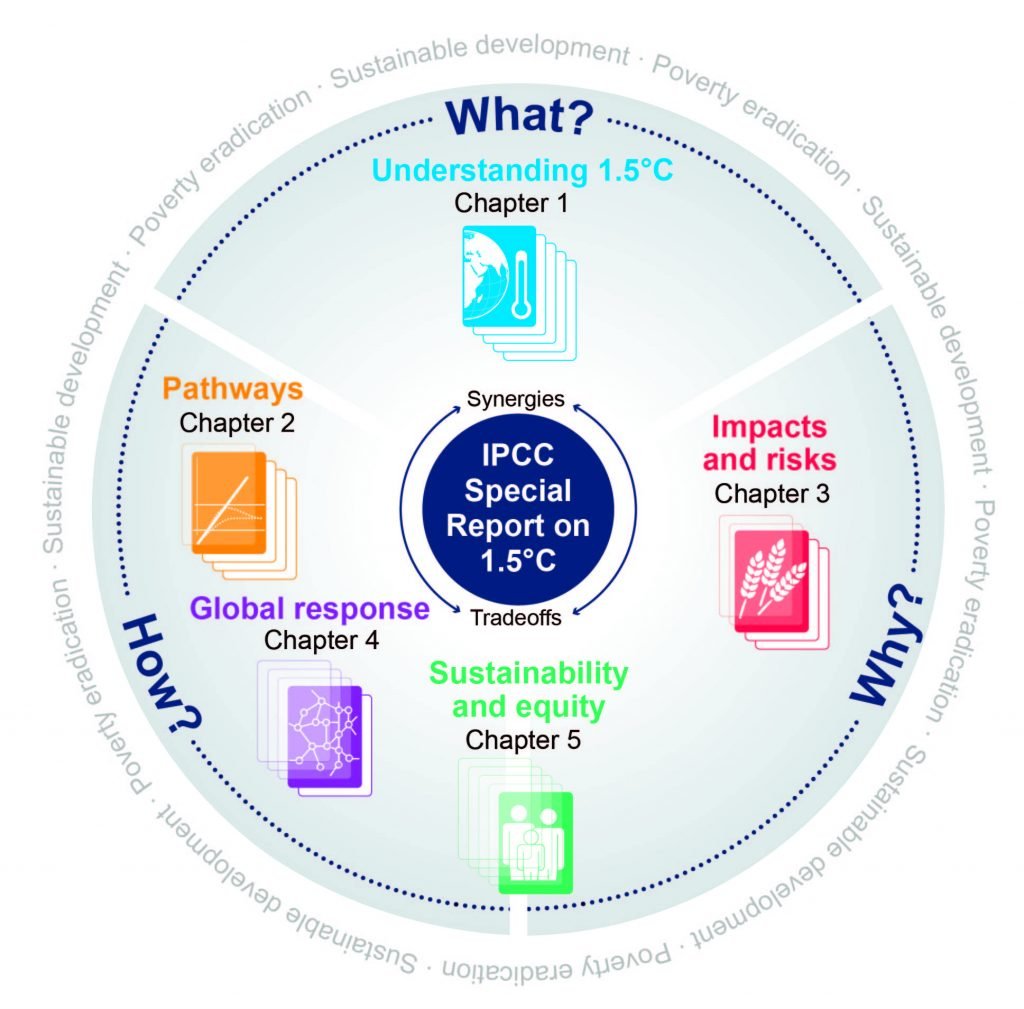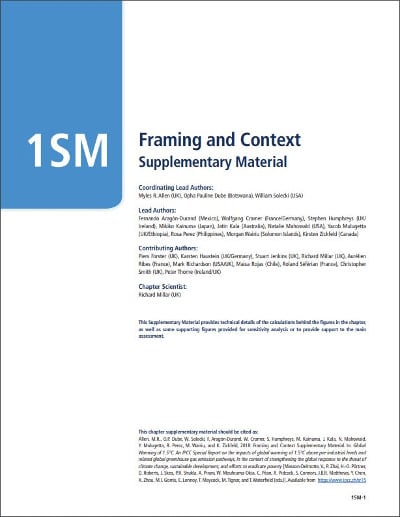ES
Executive Summary
This chapter frames the context, knowledge-base and assessment approaches used to understand the impacts of 1.5°C global warming above pre-industrial levels and related global greenhouse gas emission pathways, building on the IPCC Fifth Assessment Report (AR5), in the context of strengthening the global response to the threat of climate change, sustainable development and efforts to eradicate poverty.
Human-induced warming reached approximately 1°C (likely between 0.8°C and 1.2°C) above pre-industrial levels in 2017, increasing at 0.2°C (likely between 0.1°C and 0.3°C) per decade (high confidence). Global warming is defined in this report as an increase in combined surface air and sea surface temperatures averaged over the globe and over a 30-year period. Unless otherwise specified, warming is expressed relative to the period 1850–1900, used as an approximation of pre-industrial temperatures in AR5. For periods shorter than 30 years, warming refers to the estimated average temperature over the 30 years centred on that shorter period, accounting for the impact of any temperature fluctuations or trend within those 30 years. Accordingly, warming from pre- industrial levels to the decade 2006–2015 is assessed to be 0.87°C (likely between 0.75°C and 0.99°C). Since 2000, the estimated level of human-induced warming has been equal to the level of observed warming with a likely range of ±20% accounting for uncertainty due to contributions from solar and volcanic activity over the historical period (high confidence). {1.2.1}
Warming greater than the global average has already been experienced in many regions and seasons, with higher average warming over land than over the ocean (high confidence). Most land regions are experiencing greater warming than the global average, while most ocean regions are warming at a slower rate. Depending on the temperature dataset considered, 20–40% of the global human population live in regions that, by the decade 2006–2015, had already experienced warming of more than 1.5°C above pre-industrial in at least one season (medium confidence). {1.2.1, 1.2.2}
Past emissions alone are unlikely to raise global-mean temperature to 1.5°C above pre-industrial levels (medium confidence), but past emissions do commit to other changes, such as further sea level rise (high confidence). If all anthropogenic emissions (including aerosol-related) were reduced to zero immediately, any further warming beyond the 1°C already experienced would likely be less than 0.5°C over the next two to three decades (high confidence), and likely less than 0.5°C on a century time scale (medium confidence), due to the opposing effects of different climate processes and drivers. A warming greater than 1.5°C is therefore not geophysically unavoidable: whether it will occur depends on future rates of emission reductions. {1.2.3, 1.2.4}
1.5°C emission pathways are defined as those that, given current knowledge of the climate response, provide a one- in-two to two-in-three chance of warming either remaining below 1.5°C or returning to 1.5°C by around 2100 following an overshoot. Overshoot pathways are characterized by the peak magnitude of the overshoot, which may have implications for impacts. All 1.5°C pathways involve limiting cumulative emissions of long-lived greenhouse gases, including carbon dioxide and nitrous oxide, and substantial reductions in other climate forcers (high confidence). Limiting cumulative emissions requires either reducing net global emissions of long-lived greenhouse gases to zero before the cumulative limit is reached, or net negative global emissions (anthropogenic removals) after the limit is exceeded. {1.2.3, 1.2.4, Cross-Chapter Boxes 1 and 2}
This report assesses projected impacts at a global average warming of 1.5°C and higher levels of warming. Global warming of 1.5°C is associated with global average surface temperatures fluctuating naturally on either side of 1.5°C, together with warming substantially greater than 1.5°C in many regions and seasons (high confidence), all of which must be considered in the assessment of impacts. Impacts at 1.5°C of warming also depend on the emission pathway to 1.5°C. Very different impacts result from pathways that remain below 1.5°C versus pathways that return to 1.5°C after a substantial overshoot, and when temperatures stabilize at 1.5°C versus a transient warming past 1.5°C (medium confidence). {1.2.3, 1.3}
Ethical considerations, and the principle of equity in particular, are central to this report, recognizing that many of the impacts of warming up to and beyond 1.5°C, and some potential impacts of mitigation actions required to limit warming to 1.5°C, fall disproportionately on the poor and vulnerable (high confidence). Equity has procedural and distributive dimensions and requires fairness in burden sharing both between generations and between and within nations. In framing the objective of holding the increase in the global average temperature rise to well below 2°C above pre-industrial levels, and to pursue efforts to limit warming to 1.5°C, the Paris Agreement associates the principle of equity with the broader goals of poverty eradication and sustainable development, recognising that effective responses to climate change require a global collective effort that may be guided by the 2015 United Nations Sustainable Development Goals. {1.1.1}
Climate adaptation refers to the actions taken to manage impacts of climate change by reducing vulnerability and exposure to its harmful effects and exploiting any potential benefits. Adaptation takes place at international, national and local levels. Subnational jurisdictions and entities, including urban and rural municipalities, are key to developing and reinforcing measures for reducing weather- and climate-related risks. Adaptation implementation faces several barriers including lack of up-to-date and locally relevant information, lack of finance and technology, social values and attitudes, and institutional constraints (high confidence). Adaptation is more likely to contribute to sustainable development when policies align with mitigation and poverty eradication goals (medium confidence). {1.1, 1.4}
Ambitious mitigation actions are indispensable to limit warming to 1.5°C while achieving sustainable development and poverty eradication (high confidence). Ill-designed responses, however, could pose challenges especially – but not exclusively – for countries and regions contending with poverty and those requiring significant transformation of their energy systems. This report focuses on ‘climate-resilient development pathways’, which aim to meet the goals of sustainable development, including climate adaptation and mitigation, poverty eradication and reducing inequalities. But any feasible pathway that remains within 1.5°C involves synergies and trade-offs (high confidence). Significant uncertainty remains as to which pathways are more consistent with the principle of equity.
{1.1.1, 1.4}
Multiple forms of knowledge, including scientific evidence, narrative scenarios and prospective pathways, inform the understanding of 1.5°C. This report is informed by traditional evidence of the physical climate system and associated impacts and vulnerabilities of climate change, together with knowledge drawn from the perceptions of risk and the experiences of climate impacts and governance systems. Scenarios and pathways are used to explore conditions enabling goal-oriented futures while recognizing the significance of ethical considerations, the principle of equity, and the societal transformation needed. {1.2.3, 1.5.2}
There is no single answer to the question of whether it is feasible to limit warming to 1.5°C and adapt to the consequences. Feasibility is considered in this report as the capacity of a system as a whole to achieve a specific outcome. The global transformation that would be needed to limit warming to 1.5°C requires enabling conditions that reflect the links, synergies and trade-offs between mitigation, adaptation and sustainable development. These enabling conditions are assessed across many dimensions of feasibility – geophysical, environmental-ecological, technological, economic, socio-cultural and institutional – that may be considered through the unifying lens of the Anthropocene, acknowledging profound, differential but increasingly geologically significant human influences on the Earth system as a whole. This framing also emphasises the global interconnectivity of past, present and future human–environment relations, highlighting the need and opportunities for integrated responses to achieve the goals of the Paris Agreement. {1.1, Cross-Chapter Box 1}
